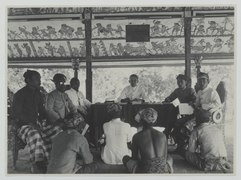
Gamelan is the traditional ensemble music of the Javanese, Sundanese, and Balinese peoples of Indonesia, made up predominantly of percussive instruments. The most common instruments used are metallophones and a set of hand-drums called kendang, which keep the beat. The kemanak, a banana-shaped idiophone, and the gangsa, another metallophone, are also commonly used gamelan instruments on Bali. Other notable instruments include xylophones, bamboo flutes, a bowed string instrument called a rebab, and a zither-like instrument called a siter, used in Javanese gamelan. Additionally, vocalists may be featured, being referred to as sindhen for females or gerong for males.
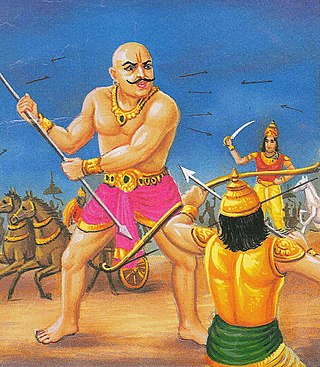
Ghatotkacha is a prominent character in the story of Mahabharata. His name comes from the fact that his head was hairless (utkacha) and shaped like a ghatam, or a pot. Ghatotkacha was the son of the Pandava Bhima and the demoness Hidimbi, and thus a half-human, half-demon hybrid.

Wayang, also known as wajang, is a traditional form of puppet theatre play originating from the Indonesian island of Java. Wayang refers to the entire dramatic show. Sometimes the leather puppet itself is referred to as wayang. Performances of wayang puppet theatre are accompanied by a gamelan orchestra in Java, and by gender wayang in Bali. The dramatic stories depict mythologies, such as episodes from the Hindu epics the Ramayana and the Mahabharata, as well as local adaptations of cultural legends. Traditionally, a wayang is played out in a ritualized midnight-to-dawn show by a dalang, an artist and spiritual leader; people watch the show from both sides of the screen.

Wayang wong, also known as wayang orang, is a type of classical Javanese and Balinese dance theatrical performance with themes taken from episodes of the Ramayāna or Mahabharāta. Performances are stylised, reflecting Javanese court culture:
Wayang wong dance drama in the central Javanese Kraton of Yogyakarta represents the epitome of Javanese aesthetic unity. It is total theatre involving dance, drama, music, visual arts, language, and literature. A highly cultured sense of formality permeates every aspect of its presentation.

Klungkung Regency is the smallest regency (kabupaten) in the island province of Bali, Indonesia. It has an area of 315 km2 and had a population at the 2010 Census of 170,543 which increased to 206,925 at the Census of 2020; the official estimate as at mid 2022 was 214,012. The administrative centre for the regency is in the town of Semarapura.
Wayang style is a style of puppetry influenced by the Indonesian wayang kulit, in which human figures and those that are supernatural are depicted as flat and very two-dimensional - hence the name wayang, meaning "shadow"). This style was commonly used in East Java during the Majapahit Empire, which lasted from about 1293 AD to around 1500 AD.

The Klungkung Palace, officially Puri Agung Semarapura, is a historical building complex situated in Semarapura, the capital of the Klungkung Regency (kabupaten) on Bali, Indonesia.
Ida Bagus Made Togog (1913–1989) was born into a noble Brahmana clan in the center of Batuan. Together with I Ngendon, he was one of the foremost painters from Batuan. Unlike Ngendon, Togog was not particularly interested in Western ideas. He was comfortable with the Balinese way of life and adhered closely to the Balinese belief system. As a member of the high priest family, Togog was very familiar with Balinese lontar and Balinese myths and folklore. His works were primarily drawn from religion and local myths from an insider's view point and he narrates them through his drawings, just like in the Wayang tradition. The strength of his drawings was neither his draftsmanship nor composition, but his narration of complex religious beliefs and the united life in Bali as a balance between the macrocosm and microcosm, between the benevolent and good spirits. According to Wim Bakker, it was the Dutch painter Rudolf Bonnet, who inspired him to translate images in Balinese lontars into drawings. During 1936 to 1938, he was befriended by Gregory Bateson and Margaret Mead and produced 83 paintings for them. As Bateson and Mead went to Bali to do research on Balinese character, they requested Togog to give an expression of his dreams. He produced a large number of drawings on dreams and his own interpretation in the context of Balinese beliefs as he understood it.

The Puri Lukisan Ratna Wartha Museum is the oldest art museum in Bali which specialize in modern traditional Balinese paintings and wood carvings. The museum is located in Ubud, Bali, Indonesia. It is home to the finest collection of modern traditional Balinese painting and wood carving on the island, spanning from the pre-Independence war (1930–1945) to the post-Independence war era. The collection includes important examples of all of the artistic styles in Bali including the Sanur, Batuan, Ubud, Young Artist and Keliki schools.
Gelgel is a village (desa) in the regency (kabupaten) of Klungkung, on Bali, Indonesia. The village, near the coast four kilometers south of the regency capital Semarapura, contains some structures of cultural interest and is known for its pottery and handwoven ceremonial songket cloth.

Dewa Agung or Deva Agung was the title of the kings of Klungkung, the foremost in rank among the nine kingdoms of Bali, Indonesia. It was also borne by other high-ranking members of the dynasty. The term Dewa means "god" and was also a general title for members of the Ksatria caste. Agung translates as "high" or "great". Literally, the title therefore means Great God.

The Dutch conquest of Klungkung, Bali in 1908 marked the final phase of Dutch colonial control over the island of Bali in Indonesia. It was the seventh and last military intervention in Bali, following the Dutch invasion of South (1906).

Dalem Di Made was a king of Bali who may have reigned in the period 1623–1642. He belonged to a dynasty that claimed descent from the Majapahit Empire of Java, and kept residence in Gelgel, close to Bali's south coast.

Kamasan is a village on Bali, Indonesia. It is reknown for a style of painting named after it and has a cultural importance on a Bali-wide level.
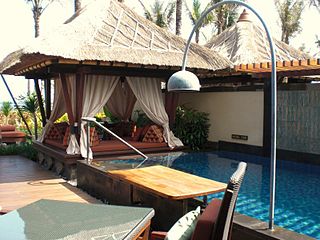
Balinese architecture is a vernacular architecture tradition of Balinese people that inhabits the volcanic island of Bali, Indonesia. Balinese architecture is a centuries-old architectural tradition influenced by Balinese culture developed from Hindu influences through ancient Javanese intermediary, as well as pre-Hindu elements of native Balinese architecture.
Mangku Muriati is a traditional-style Balinese painter and priestess from Kamasan village near Klungkung, Bali, Indonesia.
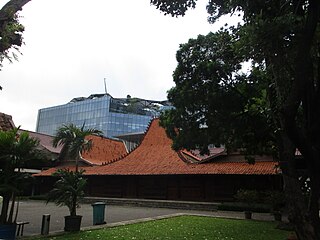
Bentara Budaya Jakarta is a cultural center located on Jalan Palmerah Selatan 17, Central Jakarta, Indonesia. The institution consists of a museum and an art gallery. Open from Monday to Friday at 8 AM to 5 PM, the gallery is closed on weekends and holidays, with an exception being made when special exhibitions are present. Entry to the gallery is free of charge and open to visitors.
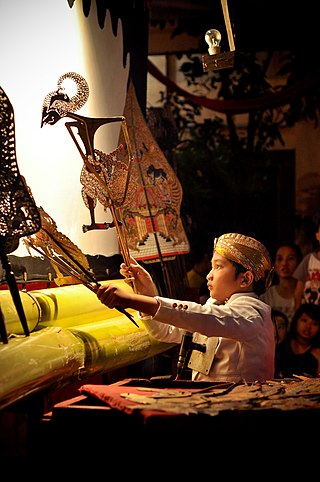
Wayang kulit is a traditional form of shadow puppetry originally found in the cultures of Java and Bali in Indonesia. In a wayang kulit performance, the puppet figures are rear-projected on a taut linen screen with a coconut oil light. The dalang manipulates carved leather figures between the lamp and the screen to bring the shadows to life. The narratives of wayang kulit often have to do with the major theme of good vs. evil.
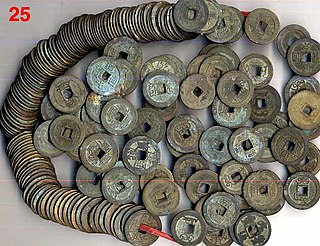
The cash coins of Indonesia was a historical currency in Indonesia based on Chinese imperial coinage during the Tang dynasty era. It was introduced by the Chinese traders, but did not become popular in Indonesia until Singhasari defeated the Mongol empire in 13th century. Chinese cash coins continued to circulate in Indonesian archipelago for centuries; when the Ming dynasty banned trade with the region, many local rulers started creating their own imitations of Chinese cash coins which were often thinner and of inferior quality. Cash coins produced in Indonesia were made from various materials such as copper-alloys, lead, and most commonly tin.

